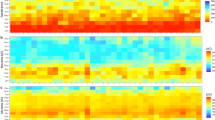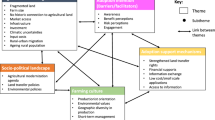Abstract
Technology adoption requires technical information to support decision-making and encourage broader acceptance. Recognizing the significance of alternate wetting and drying technology in sustainable agriculture, this study aims to promote the adoption of this technology among both Good Agricultural Practices (GAP) and non-GAP farmers in Suburban, Bangkok, Thailand. Data were collected through a structured questionnaire, which gathered information on farmers' cost and return values, as well as their adoption opinions. The collected data were then analyzed using cost and return analysis, as well as stochastic frontier analysis. The results indicate that non-GAP farmers face significantly higher total costs due to increased fixed costs compared to GAP farmers. While there were no significant differences in yield between the two groups, GAP farmers achieved significantly higher total income and net profit due to lower total costs and higher selling prices. Furthermore, the analysis suggests that both groups of rice farmers have the potential to improve their efficiency levels, with non-GAP farmers showing a higher potential for improvement. In terms of adoption opinion, both farmer groups recognize the advantages of wet and dry farming technology over traditional flooded rice farming. This study highlights that the adoption levels of both GAP and non-GAP farmers can be significantly improved through the implementation of best management practices. Overall, the findings emphasize the importance of trustworthy information dissemination to encourage the adoption of wet and dry farming technology, as it enhances farmers' trust in the received information and their engagement with the technology. The study concludes by providing policy implications and recommendations to promote the wider adoption of wet and dry farming technology.


Similar content being viewed by others
References
Akinyi DP, Ng’ang’a SK, Ngigi M, Mathenge M, Girvetz E (2022) Cost-benefit analysis of prioritized climate-smart agricultural practices among smallholder farmers: evidence from selected value chains across sub-Saharan Africa. Heliyon 8(4):1–11. https://doi.org/10.1016/j.heliyon.2022.e09228
Atwill RL, Krutz LJ, Bond JA, Golden BR, Spencer GD, Bryant CJ, Mills BE, Gore J (2020) Alternate wetting and drying reduces aquifer withdrawal in Mississippi rice production systems. Agron J 112(6):5115–5124. https://doi.org/10.1002/agj2.20447
Boyd D, Spencer R (2021) Sustainable farmer-to-farmer extension - the experiences of private service providers in Zambia. Int J Agric Sustain 20(4):443–448. https://doi.org/10.1080/14735903.2021.1939592
Cavite HJ, Kerdsriserm C, Llones C, Direksri N, Suwanmaneepong S (2022) Farmers’ perception of consumer information and adoption intention towards organic rice farming: evidence from community enterprise in rural Thailand. Outlook Agric. https://doi.org/10.1177/00307270221135250
Cavite HJM, Kerdsriserm C, Suwanmaneepong S (2021) Strategic guidelines for community enterprise development: a case in rural Thailand. J Entrep Commun 234:1–20. https://doi.org/10.1108/JEC-05-2021-0062
Ciaian P, Paloma SG, Delince J (2013) Literature review on cost of production methodologies. Food and Agriculture Organization of the United Nations, Rome
Cooperative Promotion Department (2019) Annual statistics of cooperatives, agricultural groups and vocational groups in Thailand 31st December 2018. Information and Communication Technology Center, Cooperative Promotion Department, Bangkok, Thailand
Cramb R (2020) White gold: the commercialisation of rice farming in the lower Mekong Basin. Palgrave Macmillan, Singapore. https://doi.org/10.1007/978-981-15-0998-8
Enold A, Kanjanamaneesathian M, Yoshidaa AK (2021) Factors affecting the adoption of GAP by growers in producing crops in Phetchaburi province, Thailand. Acta Hortic 1312:539–543. https://doi.org/10.17660/ActaHortic.2021.1312.76
Enriquez Y, Yadav S, Evangelista GK, Villanueva D, Burac MA, Pede V (2021) Disentangling challenges to scaling alternate wetting and drying technology for rice cultivation: distilling lessons from 20 years of experience in the Philippines. Front Sustain Food Syst 5(1):1–16. https://doi.org/10.3389/fsufs.2021.675818
FAO (2019) Country fact sheet on food and agriculture policy trends (Thailand). Food and Agriculture Organization of the United Nations. http://www.fao.org/3/I8683EN/i8683en.pdf. Accessed 20 Mar 2021
Gonzalvo CM, Tirol MSC, Moscoso MO, Querijero NJVB, Aala WF (2020) Critical factors influencing biotech corn adoption of farmers in the Philippines in relation with the 2015 GMO Supreme Court ban. J Rural Stud 74(1):10–21. https://doi.org/10.1016/j.jrurstud.2019.11.007
Howell KR, Shrestha P, Dodd IC (2015) Alternate wetting and drying irrigation maintained rice yields despite half the irrigation volume, but is currently unlikely to be adopted by smallholder lowland rice farmers in Nepal. Food Energy Secur 4(2):144–157. https://doi.org/10.1002/fes3.58
Joedsak A, Suwanmaneepong S, Thunmathiwat D (2022) Knowledge, attitudes and practices regarding good agricultural practices among rice farmers under the large agricultural plot scheme (LAPS) in Khlongudomchonlajorn, Chachoengsao Province, Thailand. World Rev Entrep 18(3):249–261. https://doi.org/10.1504/WREMSD.2022.122529
Kassem HS, Alotaibi BA, Aldosari FO, Herab A, Ghozy R (2021) Factors influencing smallholder orange farmers for compliance with GobalGAP standards. Saudi J Biol Sci 28(2):1365–1373. https://doi.org/10.1016/j.sjbs.2020.11.070
Kassem HS, Alotaibi BA, Aldosri FO, Muddassir M (2021) Exploring the relationship between information-seeking behavior and adoption of biofertilizers among onion farmers. Agron 11(6):1–17
Kerdsriserm C, Suwanmaneepong S, Mankeb P (2018) Comparative analysis of the technical efficiency of different production systems for rice farming in Eastern Thailand. Asian J Sci Res 11(4):480–488. https://doi.org/10.3923/ajsr.2018.480.488
Kılıç O, Boz İ, Eryılmaz GA (2020) Comparison of conventional and good agricultural practices farms: a socio-economic and technical perspective. J Clean Prod 258(1):1–19. https://doi.org/10.1016/j.jclepro.2020.120666
Kramol P, Suebpongsang P, Ekasingh B (2020) Farmer organizations in ubon Ratchathani Province. In: Cramb R (ed) White gold: the commercialisation of rice farming in the lower Mekong Basin. Springer, Singapore, pp 85–99. https://doi.org/10.1007/978-981-15-0998-8_4
Meelua N, Suwanmaneepong S (2021) Rice production technical efficiency in a highly urbanised area in Samut Prakan Province, Thailand. Int J Entrep Small Bus 1–10
Ministry of Agriculture and Cooperatives (2009) Good agricultural practices for rice: Thai agricultural standard TAS 4401-2008. https://www.acfs.go.th/standard/download/eng/GAP_rice.pdf
National Economic and Social Development Board (2017) Summary of the twelfth national economic and social development plan (2017–2021)
Nodin MN, Mustafa Z, Hussain SI (2022) Assessing rice production efficiency for food security policy planning in Malaysia: a non-parametric bootstrap data envelopment analysis approach. Food Policy 107(1):1–14. https://doi.org/10.1016/j.foodpol.2021.102208
Oo SP, Usami K (2020) Farmers’ perception of good agricultural practices in rice production in Myanmar: a case study of Myaungmya district. Ayeyarwady Region Agric 10(7):249
Pearson KA, Millar GM, Norton GJ, Price AH (2018) Alternate wetting and drying in Bangladesh: Water-saving farming practice and the socioeconomic barriers to its adoption. Food Energy Secur 7(4):1–12. https://doi.org/10.1002/fes3.149
Pongsrihadulchai A (2018) Thailand’s rice industry and current policies towards high value rice products. In: Paper presented at the international seminar on promoting rice farmers’ market through value-adding activities. Kasetsart University, Bangkok, Thailand, 6–7 June 2018
Prasad R, Shivay YS, Kumar D (2017) Current status, challenges, and opportunities in rice production. Rice production worldwide. Springer, Cham. https://doi.org/10.1007/978-3-319-47516-5_1
Preedasak P (2004) Principles of microeconomics, 4th edn. Thammasat University Press, Bangkok
Ruensuk N, Rossopa B, Channu C, Paothong K, Prayoonsuk N, Rakchum P, Malumpong C (2021) Improving water use efficiency and productivity in rice crops by applying alternate wetting and drying with pregerminated broadcasting in farmers’ fields. Agric Nat Resour 5(1):119–130
Sathapatyanon J, Kuwornu JKM, Shivakoti GP, Soni P, Anal AK, Datta A (2018) The role of farmer organizations and networks in the rice supply chain in Thailand. J Agribus Dev Emerg Econ 8(3):554–578. https://doi.org/10.1108/jadee-01-2017-0016
Sattaka P, Muengpak S, Xuan HP, Mueangkhot T (2020) Comparison of glutinous rice production systems for sustainable development in Sakon Nakhon Province. J Int Soc Southeast Asian Agric Sci 26(1):54–62
Seenuankaew U, Rattichot J, Leenaraj B (2018) Farmers’ information behaviors that facilitate the strengthening of their management capacity from passive to active community enterprises: Nakhon Si Thammarat. Thailand Inf Learn Sci 119(5–6):260–274. https://doi.org/10.1108/ils-07-2017-0070
Senthilkumar K (2022) Closing rice yield gaps in Africa requires integration of good agricultural practices. Field Crops Res 285(1):1–19. https://doi.org/10.1016/j.fcr.2022.108591
Stuart AM, Pame ARP, Vithoonjit D, Viriyangkura L, Pithuncharurnlap J, Meesang N, Suksiri P, Singleton GR, Lampayan RM (2018) The application of best management practices increases the profitability and sustainability of rice farming in the central plains of Thailand. Field Crops Res 220(1):78–87. https://doi.org/10.1016/j.fcr.2017.02.005
Suebpongsang P, Ekasingh B, Cramb R (2020) Commercialisation of rice farming in Northeast Thailand. In: Cramb R (ed) White gold: the commercialisation of rice farming in the lower mekong Basin. Palgrave Macmillan, Singapore, pp 39–68. https://doi.org/10.1007/978-981-15-0998-8_2
Suwanmaneepong S, Kerdsriserm C, Lepcha N, Cavite HJ, Llones CA (2020) Cost and return analysis of organic and conventional rice production in Chachoengsao Province. Thailand Org Agric 10(1):369–378. https://doi.org/10.1007/s13165-020-00280-9
Suwanmaneepong S, Mankeb P, Kuhaswonvetch S, Kerdsriserm C, Cavite HJ, Llones C (2022) Production performance and efficiency of rice farming in suburban areas of Bangkok, Thailand. J Manag Inf Decis Sci 25(4):1–12
Tabatabaei S, Mozaffari MR, Rostamy-Malkhalifeh M, Hosseinzadeh Lotfi F (2022) Using DEA models for ranking compounds as Acetylcholinesterase inhibitors in the management of Alzheimer’s. Iran J Sci Technol Trans A Sci 46(1):189–202. https://doi.org/10.1007/s40995-021-01207-z
Taherzadeh H, Tohidi G, Hsiao B (2020) Efficiency evaluation in a centralized system based on data envelopment analysis. Iran J Sci Technol Trans A Sci 44(4):1075–1084. https://doi.org/10.1007/s40995-020-00897-1
Tasila Konja D, Mabe FN, Alhassan H (2019) Technical and resource-use-efficiency among smallholder rice farmers in Northern Ghana. Cogent Food Agric 5(1):1651473. https://doi.org/10.1080/23311932.2019.1651473
Vortia P, Nasrin M, Bipasha SK, Islam MM (2021) Extent of farm mechanization and technical efficiency of rice production in some selected areas of Bangladesh. GeoJournal 86(2):729–742. https://doi.org/10.1007/s10708-019-10095-1
Voss RC, Jansen T, Mané B, Shennan C (2021) Encouraging technology adoption using ICTs and farm trials in Senegal: lessons for gender equity and scaled impact. World Dev 146(1):1–14. https://doi.org/10.1016/j.worlddev.2021.105620
Wehmeyer H, Malabayabas A, San SS, Thu AM, Tun MS, Thant AA, Connor M (2022) Rural development and transformation of the rice sector in Myanmar: introduction of best management practices for sustainable rice agriculture. Outlook Agric 51(2):223–237. https://doi.org/10.1177/00307270221086008
Wu W (2019) Estimation of technical efficiency and output growth decomposition for small-scale rice farmers in Eastern India A stochastic frontier analysis. J Agribus Dev Emerg Econ 10(2):139–156. https://doi.org/10.1108/JADEE-05-2019-0072
Acknowledgements
This work was supported by King Mongkut's Institute of Technology Ladkrabang with grant number 2563-02-04-001.
Author information
Authors and Affiliations
Contributions
The authors confirm contribution to the paper as follows: study conception and design was contributed to SS; data collection was contributed to SS, KK and LK; analysis and interpretation of results were contributed to CK and HJMC; draft manuscript preparation was contributed by SS, HJMC and PES. All authors reviewed the results and approved the final version of the manuscript.
Corresponding author
Ethics declarations
Conflict of interest
There is no conflict of interest.
Additional information
Publisher's Note
Springer Nature remains neutral with regard to jurisdictional claims in published maps and institutional affiliations.
Rights and permissions
Springer Nature or its licensor (e.g. a society or other partner) holds exclusive rights to this article under a publishing agreement with the author(s) or other rightsholder(s); author self-archiving of the accepted manuscript version of this article is solely governed by the terms of such publishing agreement and applicable law.
About this article
Cite this article
Suwanmaneepong, S., Kultawanich, K., Khurnpoon, L. et al. Production Performance and Adoption Opinion Toward Wet and Dry Farming of GAP and Non-GAP Farmers in Suburban Bangkok, Thailand. Agric Res 13, 169–181 (2024). https://doi.org/10.1007/s40003-023-00668-5
Received:
Accepted:
Published:
Issue Date:
DOI: https://doi.org/10.1007/s40003-023-00668-5




